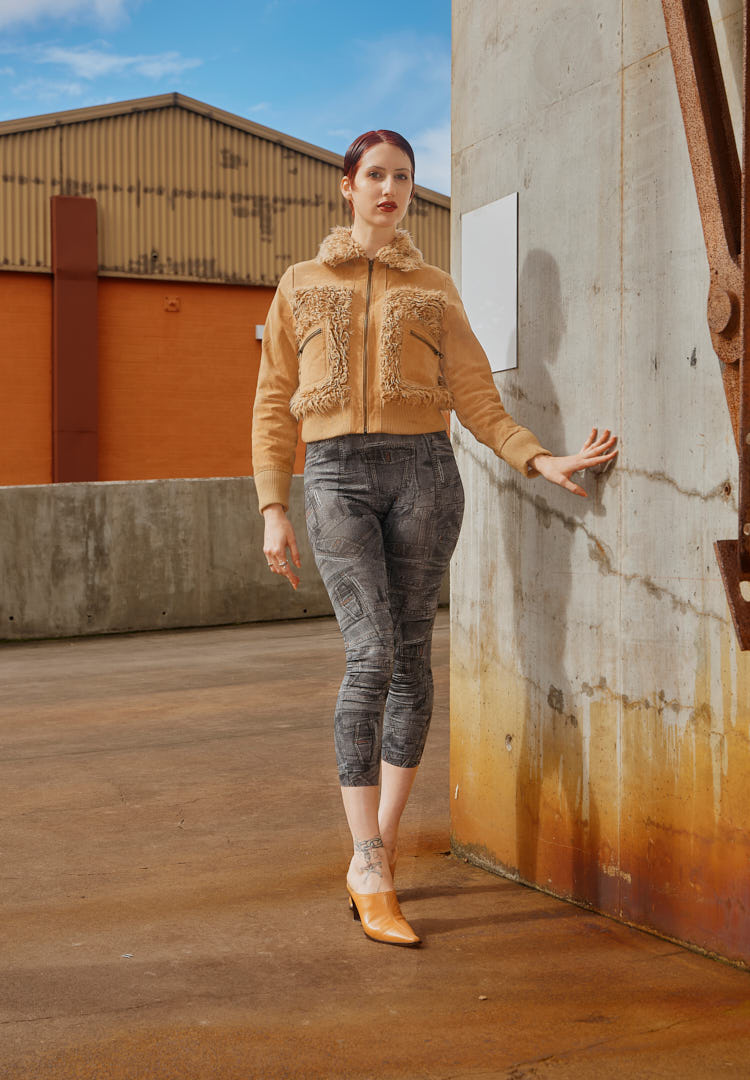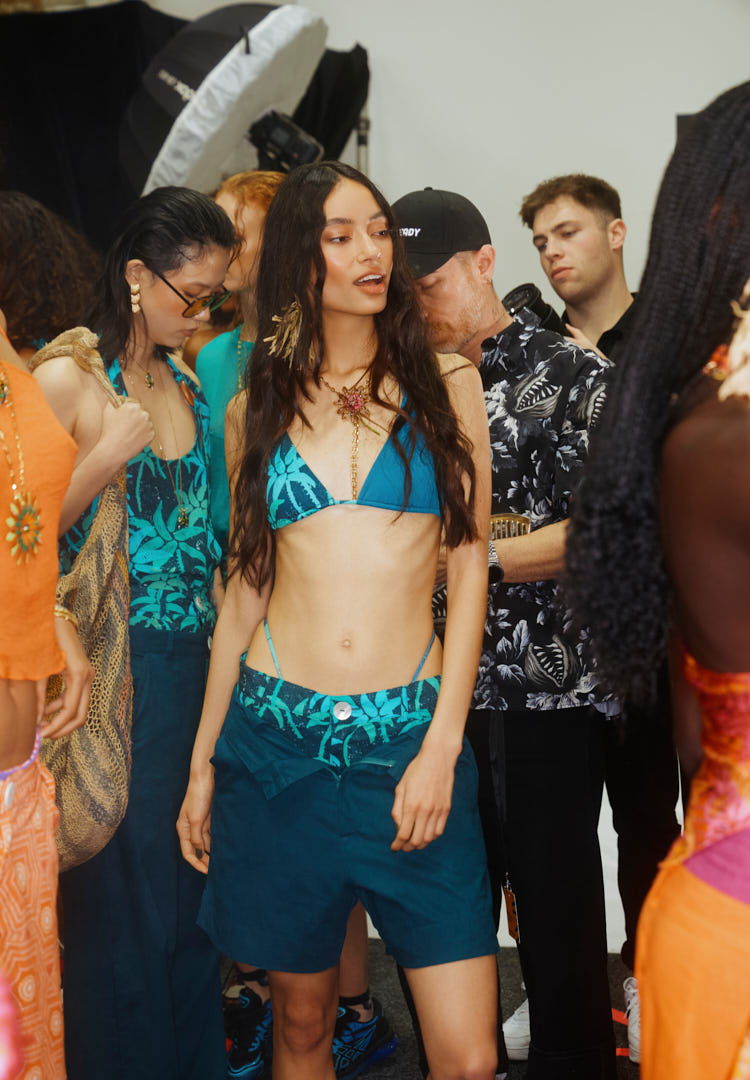Fashion’s future is circular, the proof’s at Australian Fashion Week

- by Admin
- May 22, 2024

IN PARTNERSHIP WITH EBAY
PHOTOGRAPHY BY JASON HENLEY
WORDS BY MICHELLE BAÑARES
“When people DM me about something I designed years ago and say they’re looking for it now, I know I have done my job and it’s still relevant to people’s lives.”
“This is only in its infancy,” Fashion Journal’s Managing Editor Giulia Brugliera says to me. We’re both exhausted, with clothes slightly crumpled, red-rimmed eyes and that oily but dry skin that comes from a day of adrenalin-fuelled rampaging and not enough water.
I can feel my sweat (now dried) in the slight crunch of the fabric under my armpits and the stiffness of my hair. We both feel revolting, we agree, but from an outsider’s perspective, we’re probably nothing short of fabulous. I know this because everyone around us looks fabulous and no doubt feels the exact same way.
For more fashion news, shoots, articles and features, head to our Fashion section.
It’s the tail end of Australian Fashion Week (AFW) for 2024, and we’re debriefing on the long, exhausting, brilliant week that was. There’s a lot to discuss.
We witnessed a total brand reset from one of the country’s biggest leisurewear labels at P.E Nation, were floored by the raw brilliance and originality at Nicol & Ford, marvelled at a groundswell of emerging talent at the Next Gen and The Innovators runways, and quite ran around Carriageworks – the home of AFW – to interview, network and debrief with friends and colleagues across the industry.
But no matter how many times we circle around, discussing in detail every influence, aesthetic and trend we’ve spotted at Carriageworks to date, we keep coming back to one theme: the unshakeable presence of pre-loved fashion. “We think it’s big now, but it’s only going to grow,” Giulia says. “Designers just need to work out how to embrace it.”
Me reporting as Fashion Journal’s Circular Fashion Guest Editor in entirely pre-loved fashion
It’s been a hot talking point this week after a noteworthy number of designers sent archival fashion down the runway. Alix Higgins and Albus Lumen both repurposed pieces from past seasons, breathing new life into technically ‘old’ pieces through upcycling in design. Madre Natura made headlines after showcasing a past collection in its entirety, vowing not to release any new designs until its last season sells out. ANNA QUAN injected a series of pre-loved pieces onto the runway, integrating them to appear as new season styles. They were from the Sydney designer’s past collections, no longer on sale, except through those buyers savvy (and quick) enough to snap them up on eBay after the show.
Anna opted to work with the resale platform this year, joining what was quite a bold statement from the wider industry. “Do this, or fall behind” it seemed to say. All this integration of past-season fashion has sparked a lot of in-depth conversation since. The obvious starting point is that it’s great for the environment, but is it bad for business? There’s a much greater financial incentive to push consumers to buy new season products rather than old stock – particularly when that stock is sold through a third party.
But Anna Hoang, the designer behind the eponymous label, is much too shrewd to take that at face value. Like a growing collective of her peers, she understands that consumer engagement (in any form but particularly around archival products) breeds loyalty. “With this show, I wanted to communicate that you can create things that are timeless, beautiful and unique without being basic. Evergreen and signature silhouettes have always been part of my design philosophy.
“This year, instead of reimagining these in new fabrications, we took a more direct approach and picked directly from the archives. We’ve chosen to embrace circular fashion because, apart from the environmental implications, we’ve always been about serving our customers,” she tells me.
She wants her customers to love their ANNA QUAN pieces and once they’re ready to rotate their wardrobes, she wants them to be lovingly re-homed so these pieces can feel new again. “It’s such a compliment when people come up to me and tell me they wear something to death and have gotten a lot of use out of a garment. Or when people DM me about something I designed years ago and they’re looking for it now. I know, then, I have done my job and it’s still relevant to people’s lives,” she shares.
It goes without saying that now’s a great time to list any ANNA QUAN pieces in your wardrobe. The buzz is real, with industry and consumers wanting to dive deeper into Anna’s back catalogue.
Fashion writer Maggie Zhou has already started browsing eBay for her own ANNA QUAN piece. A long-time advocate for a slower, circular fashion industry, she views AFW and eBay’s initiatives as important steps forward for Australian fashion. “Rather than shirk away from the changing way we purchase clothes, I think it’s admirable that institutions like Australian Fashion Week are adapting. We have so many garments already in circulation, why not make the most of them?”
Aside from ANNA QUAN’s show, pre-loved fashion had a presence on the Liandra runway, also supported by eBay. Each look was paired with pre-loved accessories and shoes, a nod to the way many of us are dressing now; a thoughtful mixture of high and low, new and pre-loved.
Liandra’s Designer and Founder Liandra Gaykamangu found that working with eBay on selecting these pieces was a highlight of AFW, and something that took her label’s runway to the next level.
-

The accessories at Liandra were made from pre-loved jewellery sourced from eBay
“Incorporating the pre-loved pieces from eBay really pushed me creatively. I usually play it quite safe and conservative with accessories but I enjoyed being able to repurpose the pieces, and appreciate what they were, whilst giving them new life and allowing them to evolve into something new.
“We had so much fun pulling the pieces together and I couldn’t believe how easy it was once we settled on the vision. I really saw the pre-loved pieces we sourced and repurposed, through eBay, as the cherry on top for each look,” she tells me.
The industry-wide adoption of a more circular approach to fashion wasn’t just seen on the runways either, something Maggie picked up on too. “Fashion show attendees and industry heavyweights are adopting pre-loved fashion a whole lot more. We’ve seen this year’s AFW street style sprinkled with secondhand pieces.
“People are mixing new season pieces with existing items from their wardrobe, pulling together interesting looks that blend trends, styles and decades,” she tells me.
Some of my favourite street style moments featured pre-loved fashion quite heavily. Content Creator Luca Seresin-Staig had an entirely pre-loved outfit. She wore the most incredible pair of pre-loved Miu Miu boxing boots paired with a pre-loved Comme des Garçons knit, pre-loved Levi’s baggy jeans and a pre-loved designer backpack.

Luca Seresin-Staig attends AFW wearing entirely pre-loved fashion
Meanwhile, Fashion Writer Michael Sun wore a pair of pre-loved Marséll boots he sourced back in 2018 with a vintage Cop Copine skort, a vintage blazer (unbranded, sorry), an Alix Higgins top borrowed from a friend and an incredible fur hat he found on eBay. Both wore pieces they’d borrowed from friends too, which is yet another (very underrated) way to engage in circular fashion.
eBay’s on-site activation, eBay Pre-loved Runway, provided an accessible way to partake in the circular fashion economy. At the Runway, attendees could try on a wide range of designer pieces from luxury labels like Aje, Scanlan Theodore and Zimmermann, which you can readily find on eBay. Attendees also had the opportunity to bid on items from eBay’s Style Squad, Elliot Garnaut, Jessica Pecaroro, Maggie Zhou and Jess Alizzi who had each listed their own pre-loved pieces on eBay.
Michael Sun views buying and selling on a platform like eBay as an escape from the manic pace of today’s trends. “Pre-loved fashion, by its very nature, has risen above the rapid churn of micro-trends to prove its longevity. It’s earned its spot in the wardrobe.
“Pre-loved fashion encourages us to interrogate our own personal style instead of grafting existing fads onto our wardrobe. Working with pre-loved clothing forces a designer into new and inventive territory, reshaping the past into the future,” he shares.
Aside from the ways pre-loved fashion can positively affect your sense of style, it’s also a low-effort way to create another income stream (and eliminate clutter from your wardrobe). eBay’s Fashion Lead, Anne-Marie Cheney, highlights the platform’s accessibility as the reason many fashion people choose to sell on it.
“The great thing about eBay is that anyone can start selling. With millions of people visiting the site every month, you’ve got more chances of selling your item for the best price. Sellers find themselves at the forefront of a burgeoning trend: pre-loved fashion.

Stylist Katherine Rose attends AFW in entirely pre-loved fashion
“With eBay’s research revealing a notable two in five Australians* now prioritise pre-loved purchases and are swayed by the allure of superior quality, sellers are poised to cater to a market that increasingly values style, sustainability and affordability,” she says.
I ask her if she has any advice for prospective sellers. “My top tips are to use high-quality photos, put the brand, style and size in your listing title and list via the eBay app using ‘AI magical listing’ to make it quick and easy,” she shares.
As for those looking to find that special piece, but are unsure where to start? Anne-Marie suggests perusing eBay’s The Covet List. “It’s a curated style guide featuring the hottest trends of 2024 straight from international runways.
“Crafted by leading stylists Elliot Garnaut and Jessica Peroraro, alongside pre-loved fashion enthusiasts Jessica Alizzi and Maggie Zhou, this guide offers expert advice on how to rock these trends using entirely pre-loved pieces. You can also explore our dedicated Australian Fashion Week page for our top picks and inspiration from the Australian fashion scene.”
Reflecting on this year’s AFW, the message has never been as loud and clear: pre-loved fashion is here to stay. And as a fiend for pre-loved and dedicated eBay user, I couldn’t be more on board.
Have your eye on something new? Buy it, love it, list it on eBay here.
eBay is not endorsed by or affiliated with any of the brands referenced in this article.
*Kantar research commissioned by eBay Australia surveying 3,001 Australians 18+, December 2023
The Latest News
-
January 11, 2025Sabalenka, Djokovic chase rare air at Australian Open
-
January 11, 2025Mike Davis retired from the USGA, and now he’s helping to build one of the most important new courses in the world – Australian Golf Digest
-
January 11, 2025What time is Coco Gauff’s next match at Australian Open 2025? Schedule, live stream and TV channel | Sporting News
-
January 11, 2025Carlos Alcaraz next match at Australian Open 2025: Scores, results and schedule for tennis grand slam | Sporting News Australia
-
January 11, 2025What time is Novak Djokovic’s next match at Australian Open 2025? Schedule, live stream and TV channel | Sporting News




